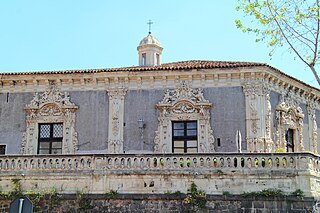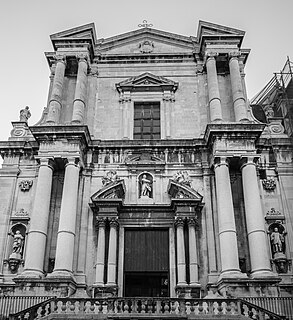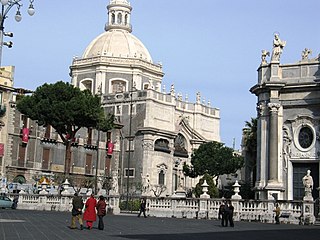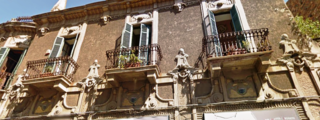
The Palazzo Cutelli is a historic palace, once housing the Collegio Cutelli, now the semiprivate Convitto Cutelli, a boarding school from primary to lyceum grades, located on Via Vittorio Emanuele #56 in central Catania, region of Sicily, Italy.

The Palazzo Cutelli is a historic palace, once housing the Collegio Cutelli, now the semiprivate Convitto Cutelli, a boarding school from primary to lyceum grades, located on Via Vittorio Emanuele #56 in central Catania, region of Sicily, Italy.
In 1654, count Mario Cutelli, a judge in Catania, endowed in his will the establishment of a private, secular college to train young noblemen in the arts of governance and law. The turbulence of the next century, including the 1693 earthquake, meant the physical construction of the present baroque architecture college was not complete until 1779, designed by Giovanni Battista Vaccarini and completed by Francesco Battaglia.
The facade is sober and broad with a set of 8 columns surrounding a central balcony with an iron balustrade. It faces the Piazza Cutelli with a central fountain with a nineteenth century fountain, Fontana delle Conchiglie, with four conch shells forming a plinth for a small obelisk. The two story structure is most impressive when viewed from within the central circular courtyard. The courtyard has white and black stone design, one of a few designed by Vaccarini in town, [1] with an elaborate design of spokes. Around this courtyard is a portico of doric pilasters supporting arches, all surmounted by a circumferential balcony. The piano nobile is accessed by an imposing stairwell. A third story is located in the portion of the college destined to house the rectors of the institution. [2] [3]

Sicilian Baroque is the distinctive form of Baroque architecture which evolved on the island of Sicily, off the southern coast of Italy, in the 17th and 18th centuries, when it was part of the Spanish Empire. The style is recognisable not only by its typical Baroque curves and flourishes, but also by its grinning masks and putti and a particular flamboyance that has given Sicily a unique architectural identity.
Giovanni Battista Vaccarini was a Sicilian architect, notable for his work in the Sicilian Baroque style in his homeland during the period of massive rebuilding following the earthquake of 1693. Many of his principal works can be found in the area in and around Catania.

Palazzo Borghese is a palace in Rome, Italy, the main seat of the Borghese family. It was nicknamed il Cembalo due to its unusual trapezoidal groundplan; its narrowest facade faces the River Tiber. The entrance at the opposite end of the building, the "keyboard" of the cembalo, faces onto the Fontanella di Borghese, with another in a great flanking facade to the Piazza Borghese that is extended by a slightly angled facade leading down Via Borghese towards the river. Both these entrances lead into a large courtyard on one side of which is a two level open arcade, with paired Doric and Ionic columns, that frames the garden beyond.

Stefano Ittar was a Polish-Italian architect.

Palazzo Aragona Gonzaga is a 16th-century palace in Rome, Italy; it was once the residence of Cardinal Scipione Gonzaga. Today, its late Renaissance street facade bears plaques commemorating two of its residents, Saint Aloysius Gonzaga and the poet Torquato Tasso.

Palazzo degli Elefanti is a historical building in Catania, region of Sicily, southern Italy. It currently houses the city's Town Hall. In the past, the prior building was also known as the Palazzo Senatorio or Loggia Senatoria.

The Palazzo Biscari is a monumental private palace located on Via Museo Biscari in Catania, Sicily, southern Italy. The highly decorative interiors are open for guided tours, and used for social and cultural events.

The Palazzo Tezzano is a monumental palace in Piazza Stesicoro, in the center of Catania, Sicily, southern Italy. The via Etnea, with prominent shops, bisects the Piazza; this palazzo rises at the northwest intersection with this via, across from the white stone, neoclassical Palazzo Paterno del Toscano.

The Palazzo Orsini di Gravina is a Renaissance-style palace on number 3 Via Monteoliveto, in the San Lorenzo quarter of Rione San Giuseppe-Carità, of central Naples, Italy. Since 1940, it has housed the Faculty of Architecture of the University of Naples. It is located across the street and a few doors north of the sleek and modern Palazzo delle Poste. Across the street at the north end of the palace, is the Piazza Monteoliveto with its Fountain and the church of Sant'Anna dei Lombardi.
Piazza del Duomo is the main city square in Catania, Italy, flanked by both the centers of civic and religious power.

San Giuliano is a Roman Catholic church and attached convent located on Via Crocifero #36 of Catania, Sicily, southern Italy. It stands across from the Collegio dei Gesuiti, whose church of San Francesco Borgia also faces Crociferi. Two blocks north on Crociferi is the baroque church of San Camillo de Lellis.

San Francesco Borgia is a Roman Catholic church located on Via Crociferi #7, adjacent to the former Collegio Gesuita, and parallel to San Benedetto, and about a block south on Crociferi of the church and convent of San Giuliano, in the city of Catania, region of Sicily, southern Italy. The church is mainly used for exhibits, but still holds much of the original Jesuit artwork.

The Palazzo San Giuliano is a monumental palace located in Piazza Universitaria, in the center of the city of Catania, Sicily, southern Italy. Once a private home, it has also served as hospital, bank, theater, and hotel. Presently it houses the administrative offices of the University of Catania, and stands across the piazza from the Palazzo dell'Università, which has the rector's offices, a library, and a small museum.

Badia di Sant'Agata or Abbey of St Agatha refers to an 18th-century Roman Catholic church and attached female convent located on Via Vittorio Emanuele #182 in the center of Catania, region of Sicily, southern Italy. The Baroque style church facade is across the street from the left transept of the Cathedral of Catania.

The Palazzo dell'Università or Palazzo Centrale dell'Università di Catania is a monumental palace located in Piazza Universitaria, in the center of the city of Catania, region of Sicily, southern Italy. Since its construction, it has housed the main offices of the University of Catania, and stands across the piazza from the Palazzo San Giuliano, also housing offices of the university. It presently houses the offices of the rector, university offices, the Biblioteca regionale “Giambattista Caruso”, and a small museum of geology and archeology.

The Palazzo Paternò del Toscano, also known as the Palazzo del Toscano, is an notable palace in Piazza Stesicoro, in the center of Catania, region of Sicily, southern Italy. The building now houses many shops, but is also used by schools, and for cultural programs. The white stone facade stands before the Monument to Vincenzo Bellini and rises in contrast to the palace across via Aetna, the white and black Palazzo Tezzano.

The Palazzo delle Poste is an notable building, called a palace, but built for and still housing postal offices. It stands on the west corner of Via Etnea, #288, where it intersects with the start of the Giardino Bellini.

The Palazzo Gioeni Asmundo is an notable palace located on via Fragalà #10 facing Piazza dell'Università in the center of Catania, region of Sicily, southern Italy. The building, like the two other prominent palaces facing this piazza, now houses offices of the University of Catania.

The Palazzo del Seminario dei Chierici, also known as the Palazzo dei Chierici is a monumental building located facing the piazza Duomo in Catania, region of Sicily, Italy. It stands aside from the Cathedral of Sant'Agata, and across the piazza from the Palazzo degli Elefanti, which houses city hall. Between these two palaces, the Monument of the Elephant with obelisk is located.

The Garage Musumeci is an notable building, elaborated in a flamboyant Liberty style, and built to house both an automobile showroom on the ground floor and above the apartments of the owner, Baron Musemeci. It is located in Piazza Bovio, at the intersection of Via Conte di Torino and Via Francesco Crispi, in the city of Catania, region of Sicily, Italy.